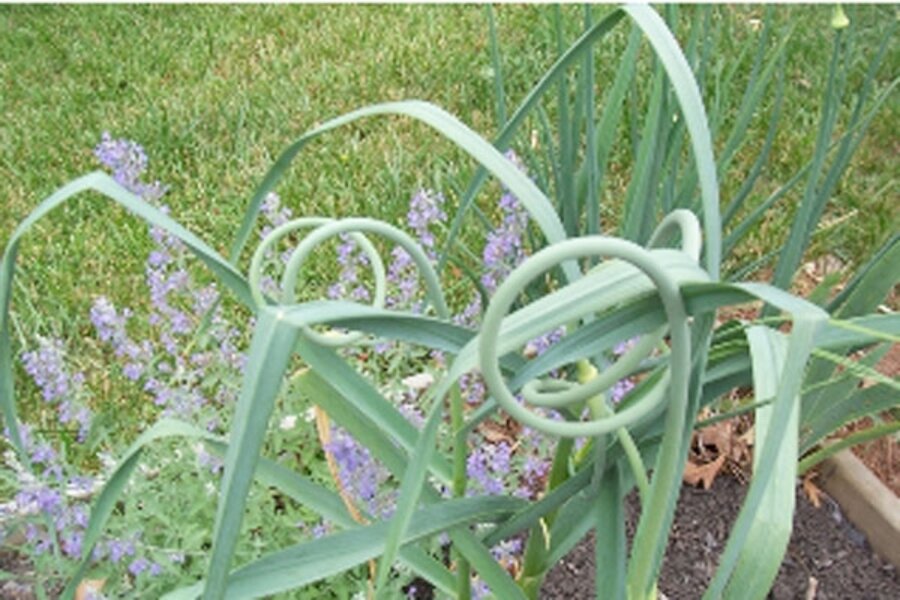Garlic can be ornamental as well as tasty
Loading...
In the old days, I used to separate garlic cloves purchased from the supermarket and plant them in my garden. I wasn’t careful about where I planted them, not necessarily giving them the good drainage they needed year-round.
They never did very well. Then I made my first trip to Chanticleer Garden in Wayne, Pa. At that time, Chris Woods was director, and I was stunned by his vision and technique. I had never seen such a beautiful and skillfully designed garden. And he used garlic as an ornamental!
Chris put plants in delightful combinations or used them in interesting new ways. He developed a colchicum lawn with a magenta Adirondack chair for a fall display of that beautiful waterlily-like bulb that was breathtaking. He planted a gravel bed with butterfly weed (Asclepias tuberosa), winecups (Callirhoe involucrata), and Gladiolus ‘Atom.'
So when he planted a garden with lavender ‘Colchester White’ centaurea, and a swirly-headed garlic, I knew I was in a new world of gardening. My friend Karen and I talked with Chris at length about his work at Chanticleer and at harvest time, he generously sent us some garlic.
Ever since, I have been growing what I think is the hard-neck ‘Rocambole’ garlic (in my mind it’s the ‘Chanticleer’ garlic) in my garden and in the gardens of my willing design clients.
Often I plant the garlic as a counterpoint among mounding perennials or in grasses like Mexican feather grass (Nasella tenuissima), a cool-season grower with incredibly thin leaves – soft and full of movement. It goes into the rose bed to annoy the deer, and sometimes I like it with one of the dwarf catmints, perhaps ‘Select Blue’ or ‘Little Titch.'
The garlic emerges early in spring and develops a fantastic double swirling stem or scape for the flower bud. It looks like a swan in the garden. (See first photo above.)
As the plant develops, the swirl unwinds and the scape elongates with the pointy flower bud swelling and becoming more rounded. Cutting off the swirling scape before the flower develops can have a delicious side benefit: Roughly chop the scapes and sauté in butter for a delicate garlic side dish. Removing the garlic flower bud allows the plant to put its energy into the bulb rather than into the flower.
You can also let the flower bloom and be pollinated, developing tiny seeds and bulblets. I’ve done this, planted the seeds in flats first or directly the ground. It takes about two years for the garlic plant to reach flowering size from seed.
Once the stem turns brown, the garlic harvest can begin. In the loose soil of my raised beds and perennial border, this is an easy task. I pull on the dry stem and the garlic pops out of the ground. In firmer ground, you might need a garden fork to loosen the soil. I dry the bulbs outside in a shady spot for a month. (See second photo above.)
Once dry, the roots and stem can be trimmed; the stem should not ooze any water – if it does, allow to dry longer. The papery covering of the cloves can be rubbed off and a fresh, clean papery layer will appear. (See third photo above.)
Save some cloves for replanting in August in a sunny location with good drainage. They're very tasty and so beautiful. This reminder of Chris Wood’s generosity and vision is multiplied and renewed every year in my garden. He planted some garlic and made me a better gardener.
For more information on planting garlic, click here.
Donna Williamson is going to be a regular blogger on Diggin' It. She is a master gardener, garden designer, and garden coach. She has taught gardening and design classes at the State Arboretum of Virginia, Oatlands in Leesburg, and Shenandoah University. She's also the founder and editor of Grandiflora Mid-Atlantic Gardening magazine, and the author of "The Virginia Gardener's Companion: An Insider's Guide to Low Maintenance Gardening in Virginia." She lives in the Shenandoah Valley of Virginia.
Editor’s note: For more Monitor gardening, see our main gardening page. Our blog archive. Our RSS feed.
You may also want to visit Gardening With the Monitor on Flickr. If you join the group (it’s free), you can upload your garden photos — and possibly win a prize. Deadline is Aug. 11. Join the discussions and get answers to your gardening questions.





